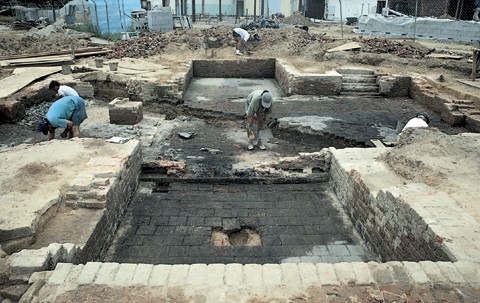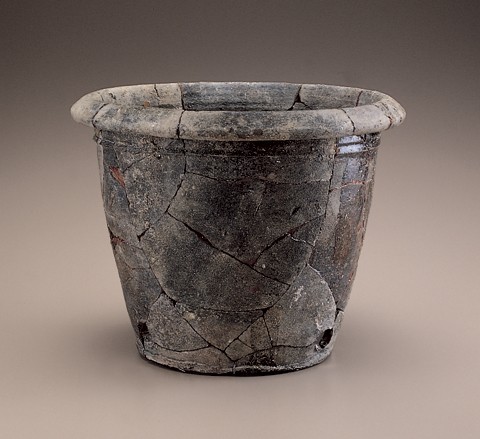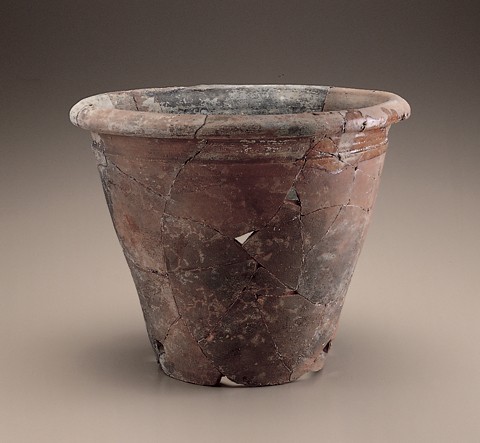
Reconstructed earthenware owerpots being examined in Colonial Williamsburg’s archaeological laboratory. (All illustrations courtesy Department of Archaeological Research, Colonial Williamsburg Foundation; photo, Gavin Ashworth.)

View of archaeological excavation of the John Page House. (Photo, Department of Archaeological Research, Colonial Williamsburg Foundation.)

Flowerpots, England, possibly London, ca. 1700. Earthenware. H. of tallest: 10 1/2". (Photo, Gavin Ashworth.) A comparison of the largest and the smallest pots.

A view of the drainage holes of earthenware owerpots.

Flowerpot , England, possibly London, ca. 1700. Earthenware. H. 6 7/8". (Photo, Gavin Ashworth.)

Flowerpot, England, possibly London, ca. 1700. Earthenware. H. 8 3/4". (Photo, Gavin Ashworth.)

Flowerpot, England, possibly London, ca. 1700. Earthenware. H. 10 1/8". (Photo, Gavin Ashworth.)
There is a paradox in material culture that the most common everyday objects in a given society are the ones least likely to survive the passage of time. Above ground anyway. Archaeologists can attest to the tremendous volume of crockery that bears little resemblance to the ceramics specimens preserved in the world’s museums and private collections. Unfortunately, archaeologists usually are left with fragmentary examples to try to understand ceramic history, although occasionally an object is discovered nearly intact or one that can be pieced together from fragments. Outside of shipwreck cargoes, complete pots are rarely found in archaeological contexts.
A recent exception was the discovery of eighteen nearly complete earthenware ower pots in the excavation of a colonial cellar in Williamsburg, Virginia (fig. 1). Colonial Williamsburg’s Department of Archaeological Research undertook the excavation in 1995 in advance of new construction on its property (fig. 2). The cellar was part of an imposing brick manor house built by John and Alice Page in 1662 on the outskirts of what was to become the town of Williamsburg in 1699.
John Page was one of the most eminent men in the Virginia colony and appears to have maintained a well-landscaped plantation. He lived in the house until his death in 1692, and his wife lived in the house until her death in 1698. Ownership of the house remained in the family, although it is unclear who actually occupied the manor house. The last probable inhabitant was John Page III who may have resided there from 1718 until his death in 1727. Archaeological evidence suggests the house burned between 1725 and 1730, but it is unclear if this was before or after John Page III’s death.
Houses that have burned filled with their contents, though tragic, can provide the best contextual information an archaeologist can hope for. They can provide a snapshot in time of the types and range of materials. The Page house is one of a handful of archaeologically excavated eighteenth-century burned house sites in colonial America. Sixty glass wine bottles, apparently full at the time of the house fire, were among the many artifacts recovered. Other household ceramics, probably having fallen from the oors above, were also recovered. These have been summarized elsewhere.[1]
Although frequently encountered in the excavation of colonial American sites, owerpots are among the least documented ceramic forms. Archaeological research in the town of Williamsburg has revealed fragments of owerpots on nearly every house lot. It is clear that they were plentiful and widely used.[2] The promotion of formal gardens was a direct import of the British practices particularly in the seventeenth and eighteenth centuries. The established gardens of Williamsburg and other prominent seats are well known, and the practice was considered a badge of rank for most Virginia gentlemen.[3]
At the time the Page house burned, the pots were being stored, possibly forgotten, in the cellar. The plainness of the pots combined with their English origin suggests that they were initially used to ship plants and young trees to the American colony. Precedence for this practice is well documented in the orders and shipping instructions of American gardeners to their London suppliers.[4]
The clay body of the pots has been identified as English, and they were possibly made in or near London. As most potters are creatures of habit, they tend to throw pots repeating the same forms or decorations. In many cases, these idiosyncrasies make it possible to separate the work of one potter from another simply by observing the distinctive way that rims are formed, handles are applied, or footrings are trimmed. All but one of the Page site owerpots have strikingly similar characteristics, suggesting that one craftsman produced them.
They each have a distinctive raised v-shaped cordon, positioned below the rim on the exterior (fig. 3). The rim profiles are similar, being generally rounded in section, with a slightly attened, down-angled upper surface. All the pots are at bottomed and have sides that are upward to the rims. The smallest size pots have a single, centrally positioned drain hole in their bases, while the medium- and large-size pots have three evenly spaced holes through the pot wall near the base, in addition to the central base hole (fig. 4). The potter formed all these drain holes by pushing through the pot walls from the outside inward. The odd pot in the group is a large example with a fully rounded rim, no raised exterior cordon, and only one central base drain hole that was fettled (trimmed) so that it is now impossible to determine from which direction the hole was formed. The base diameter of this lone example is larger than the average base diameter of the others in the assemblage.
The Page site owerpots have been sorted into three groups based on their size and the number and location of the drainage holes. Five small size pots measure from 6 7/8" to 7 1/2" in height and range from 6 7/8" to 7 1/2" (maximum exterior diameter) at their rims (fig. 5). Nine pots comprise the medium size group, which measures from 8 3/4" to 9 1/8" in height, with rim diameters from 11" to 12 1/2" (fig. 6). The large size group contains three pots, the shortest being 10 1/8" and the tallest 10 1/4", with rim diameters ranging from 12 7/8" to 13 1/2" (fig. 7).
Even though the fire that consumed the Page house discolored most of the surfaces of the pots, undamaged clay fabric survives in all of the specimens. The coarse earthenware clay body is a fairly homogenous, reddish-brown color with obvious sand inclusions. The owerpots are unglazed except for random splashes of a clear lead-uxed glaze on interior and exterior surfaces. Two of the medium size pots show scars in their glaze splashes where smaller pots (with base diameters of approximately 5") came in contact during firing. The pots fused together and had to be broken apart for use. Other smudges of thin glaze appear haphazardly on the exteriors under rims and on the bases of each pot in the assemblage.
Flowerpots are but one of many types of gardening evidence found on archaeological sites in Williamsburg; this assemblage is the largest group of nearly complete owerpots that has come to light thus far. Further analysis of the full range of gardening equipment, coupled with new analytical procedures being developed in the field of archaeobotany, will undoubtedly advance our understanding of eighteenth-century landscapes and horticulture.
William Pittman
Curator of Archaeological Collections
Colonial Williamsburg Foundation
<wpittman@cwf.org>
Robert Hunter
Editor, Ceramics in America
<CeramicJournal@aol.com>
John Metz, Jennifer Jones, Dwayne Pickett, and David Muraca, “Upon the Palisao” and Other Stories of Place from Bruton Heights (Williamsburg, Va.: Colonial Williamsburg Foundation, 1998).
Audrey Noël Hume, Archaeology and the Colonial Gardner, Colonial Williamsburg Foundation No. 7 (Williamsburg, Va.: Colonial Williamsburg Foundation, 1978).
Peter Martin, The Pleasure Gardens of Virginia: from Jamestown to Jefferson (Princeton, N.J.: Princeton University Press, 1991).
Ann Leighton, American Gardens in the Eighteenth Century: “For Use or for Delight” (Boston: Houghton Mippin, 1976).
